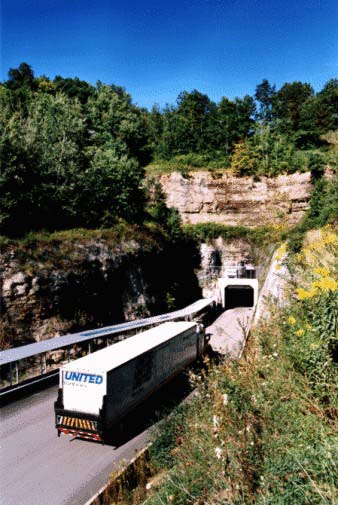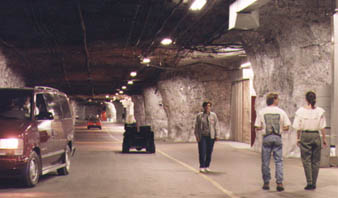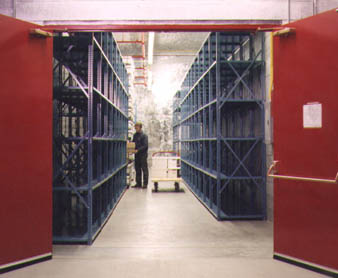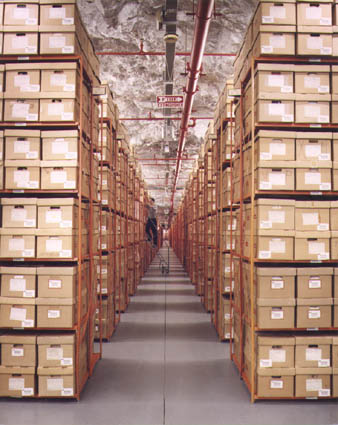
Adaptation of Underground Space
An examination of the opportunities and challenges of keeping paper,
film, and magnetic media in underground facilities
by Tom Benjamin
March 1999
The degree of security afforded your important records is one of the most important considerations when choosing a records storage site whether on-site or off-site. Nothing else will matter if something happens to your important records. A visual inspection and evaluation of your records storage location could be the best time investment you might ever make.

BACKGROUND OF UNDERGROUND FACILITIES
- The majority of the underground storage facilities are located in mines.
These include limestone, iron ore, and salt.
- Underground storage first became attractive because of the "cold war."
OPPORTUNITIES
- Storage for microfilm, motion picture film, audio/video tape, magnetic
media, paper.
- Secure site for data centers.
- The advantages offered underground include:
- security
- excellent fire protection
- no change in environmental conditions
- Office site for confidential business functions.
- Manufacturing site
- Warehouse
ADVANTAGES
- Highest level of physical security due to limited accessibility.
- Underground storage facilities provide for excellent physical protection
of records.
- Immune from most natural and man-made disasters such as fire, flood,
theft, civil disorder, aircraft crashes, tornadoes, lightning.
- What about earthquakes?
- Proper environmental conditions are easy to maintain.
- Maintaining the proper storage conditions underground is easy but there
are still some challenges.
- Identify your targeted storage conditions.
- Underground we can maintain temperatures in the 60F range with standard
industrial air conditioning equipment.
- Underground it's a constant temperature (58F good) and RH (85% ugh).
- We use Mother Nature to assist us in maintaining the temperature and
desiccant dehumidifiers to control the RH.
- The dehumidifier size is based on the size of the storage area and the
environmental specifications selected by the client.
- We use a modular approach with our HVAC equipment.
- Fire protection is easy underground.
- Existing rock walls are used to separate the space into "rooms" or
individual "compartments".
- Fire Suppression: we use a number of fire suppression systems:
- Wet and pre-action sprinklers
- Halon
- FM-200
- CO5
- On-site Fire Brigade
- Low cost compared to above ground.
- Underground construction costs are relatively low.
- Underground maintenance costs are low.
- Underground power costs are low.
- Underground property taxes are low.

CHALLENGES
- Temperature and humidity control can be a challenge too.
- Insulation: Insulation is always recommended when refrigeration equipment
is installed.
- Vapor barrier: A good vapor barrier must be used if you hope to maintain
your selected storage specifications and operate your HVAC system
economically.
- Epoxy paint and or a plastic barrier is very effective.
- Don't underestimate vapor pressure. It's been known to peel paint from
wall surfaces.
- Positive pressure: fresh air needs to be brought in through the
dehumidifier as make-up air.
- Maintain a higher air pressure inside the room than outside.
- Reduce the build-up of contaminants within the vaults.
- Doors and Anterooms
- Doors to refrigerated areas should be insulated and tightly weather
stripped.
- We recommend an anteroom be constructed between the cold vault and
outside ambient conditions.
- Hey, you're underground and in the middle of no where!
- What about ground water from above or below?
- Construction and Maintenance
- Who does construction underground?
- Nothings straight or square
- Rest Rooms and Sewerage
- Potable Water Supply
- Ventilation and Air Quality:
- Your best bet is to select an underground location that has clean air.
- Air contamination can be solved by two methods
- dilution
- filtration
- Test the air quality using an independent testing lab
- Emergency Power
- It is critical that your storage facility have emergency power
provisions.
- Limit your risk to disaster
- Schedule Emergency Drills
- Test your systems in accordance with NFPA regulations.
- Eliminate potential risks:
- no compressed gases
- limit what you store
- limit and control access to the facility
- screen all visitors
- positive id required
- maintain a low profile within the community
- Create "No-Nonsense" Business, Safety and Fire Practices and verify that
they're in place.
- Record the temperature and humidity constantly.
- Test air quality.
- Design all storage areas to minimum 3 hour fire rating.
- Equip all storage areas with ionization smoke detectors and automatic
sprinkler systems.
- Insure all areas have portable fire extinguishes per NFPA Code.
- Compartmental rooms to limit fire exposure.
- Limit public access.
- Personnel are security cleared, bonded and monitored by specific
assignment schedules.
- Sprinkler systems and smoke detectors audited by a certified outside
entity.
- Full, all personnel, evacuation drills are held twice annually.
- Critical systems (lighting, ventilation, alarm, communication) are
powered by an emergency generator.
- Armed guards and other support personnel are on site on duty 24 hours a day 365 days per year.

Tom Benjamin, Vice President of Business Development, National Underground Storage, Inc. (NUS).
Tom is associated with and has given presentations to the Association of Records Managers and Administrators, Association for Information and Image Management, Nuclear Information and Records Management Association and Association of Moving Image Archivists.
